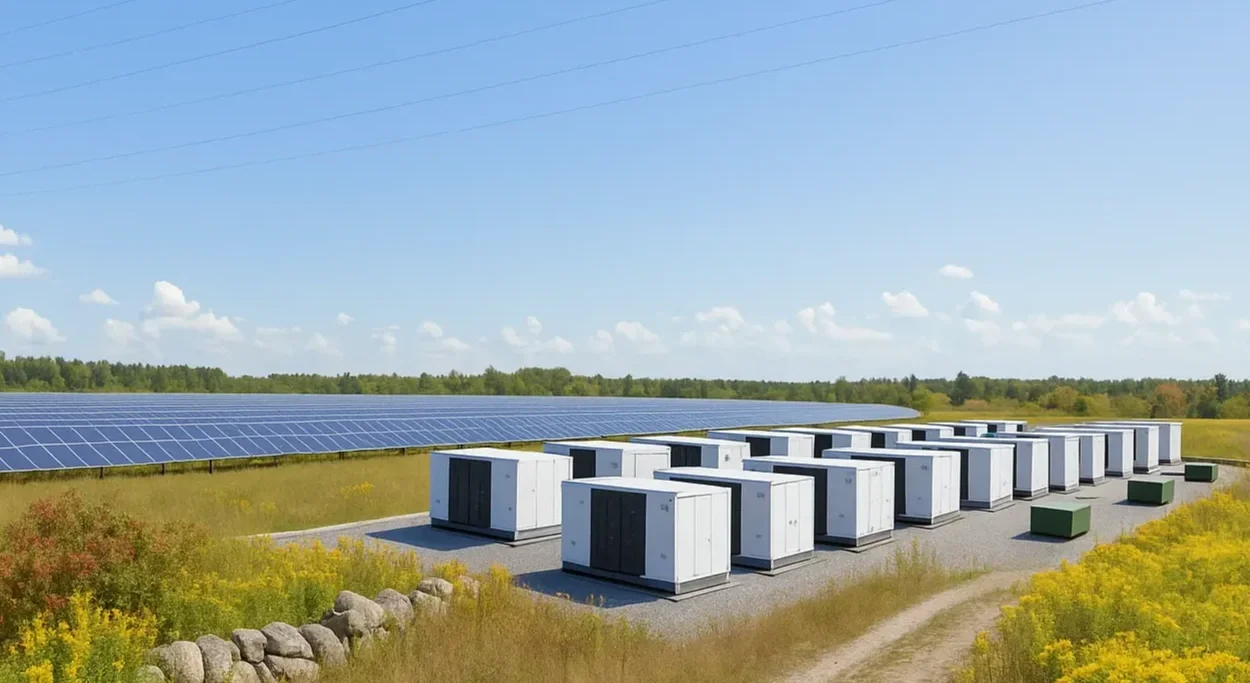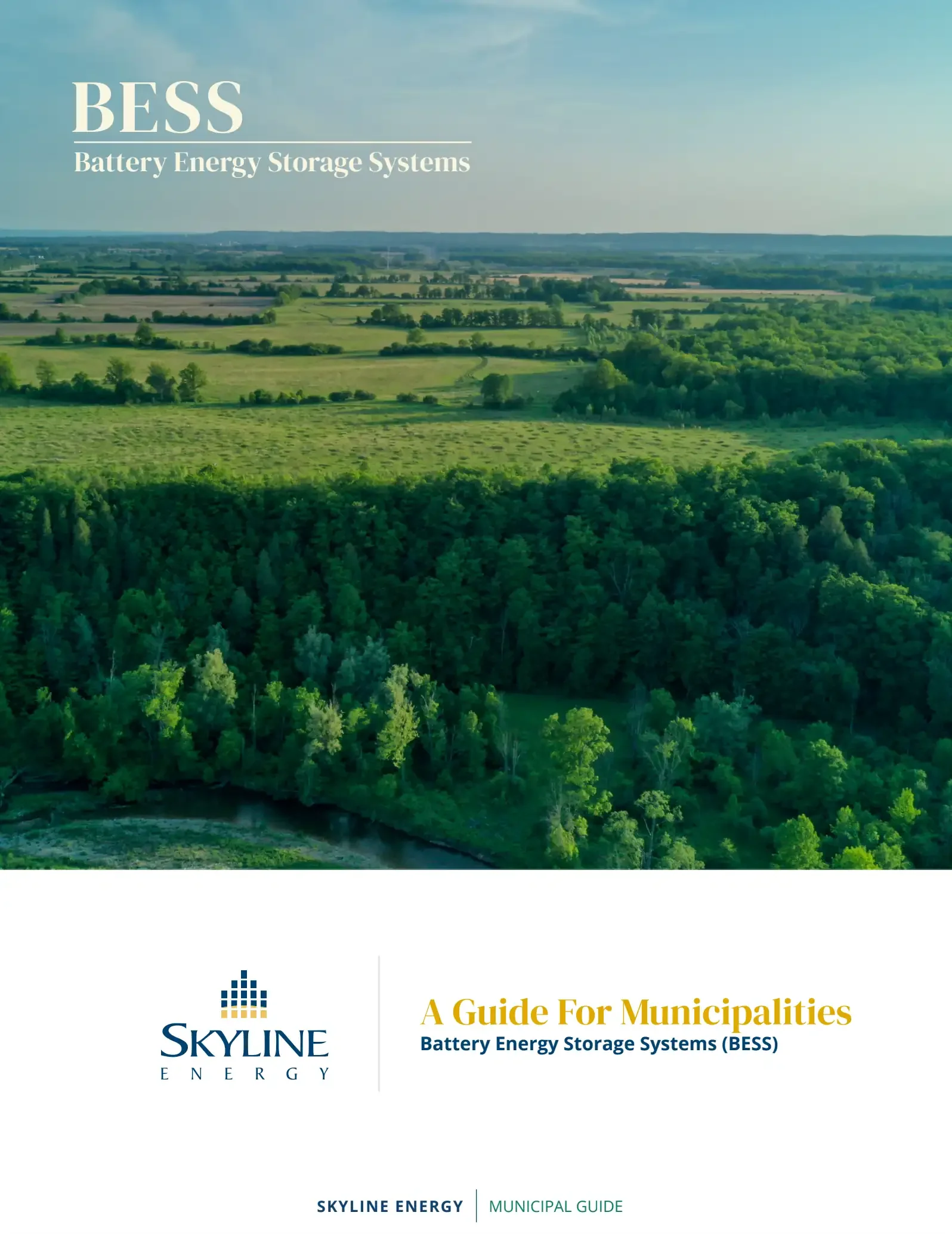Balsam Lake BESS
Meet the Project
Balsam Lake BESS
Balsam Lake BESS will total ~3 acres, providing 23 megawatts of battery energy storage. It will be located in Kawartha Lakes, Ontario Near on 1246 Northline Road. This project would provide enhanced grid stability for Ontario, and be able to provide up to 7,000 homes with stabilized, reliable, clean energy.
-
Balsam Lake BESS
-
23MW / 184MWh
-
Skyline Energy
-
1246 Northline Road, Kawartha Lakes
This pin is approximate and may not represent the actual site address.
What is a BESS?
Battery Energy Storage Systems (BESS) store electricity from the grid during low-demand periods and discharge it when demand is high. These facilities are clean, quiet, and essential to modernizing Ontario’s power system.
Why Ontario Needs BESS
Ontario is facing a growing energy gap due to retiring nuclear stations and increasing electrification.
BESS typically serves as a clean alternative to gas power plants, enabling better integration of renewable energy sources into Ontario’s grid.
BESS helps stabilize the grid, supports renewables, reduces peak demand stress, and stabilizes energy prices.
Ontario’s grid operator, the IESO, is currently procuring both gas plants and clean energy storage through the LT2c competitive processes.

-
Stable property tax revenues for 20+ years.
-
Construction, operations, and maintenance jobs.
-
Direct funding to municipalities via Community Benefit Agreements.
-
Environmental leadership through adoption of clean technology.
-
No water or sewage use during operation.
-
Quiet operation and sound mitigation where needed.
-
Sealed enclosures to prevent environmental risk.
-
Land restoration and decommissioning plans included.
-
Typical BESS sites are relatively compact compared to the value they provide the grid and are often under six acres for a 40 MW / 320 MWh system. Enclosures resemble shipping containers and are screened with fencing and/or landscaping.
-
Noise is similar to an HVAC unit and is mitigated with sound barriers if needed. No lighting is used during normal operation. After construction, traffic is minimal—limited to occasional maintenance visits. There are no full-time staff on-site—the systems are monitored remotely 24/7.
-
Yes. BESS facilities use Lithium Iron Phosphate (LFP) batteries, known for stability and safety. They include automated monitoring, fire suppression, and are built to strict codes (e.g., UL 9540A, NFPA 855). Local emergency services are trained and involved in planning. BESS fires are extremely infrequent (~1 incident per 10,000+ installations per year) and are far less common than fires at other industrial locations.
-
No. BESS has no operational emissions, no water use, and no fuel. Batteries are sealed, and containment systems mitigate leaks from affecting land or water.
-
The batteries are sealed in weatherproof steel enclosures mounted on engineered concrete pads with curbing and controlled drainage. There is no discharge or leakage of the units unless they become damaged.
The site is designed under Ontario’s stormwater guidelines so that rainwater (and any firefighting water in the very rare case of a fire incident) is directed to on-site containment and tested/managed before discharge. If an Environmental Compliance Approval (ECA) is required for any discharge, it’s reviewed and permitted by the Ministry of the Environment, Conservation and Parks.
This project uses lithium-iron-phosphate (LFP) chemistry, which is widely recognized for higher thermal stability and lower risk of thermal runaway compared with some other lithium-ion chemistries (e.g., NMC). That inherent stability reduces the likelihood of any release in the first place.
Independent reviews of battery incidents show that, even when fires occur, measured levels of contaminants in air, soil, and water have not required remediation; byproducts from LFP lithium-ion batteries are generally of low solubility in water, and standard stormwater controls limit off-site movement.
Note that the main chemical that would be released in an LFP BESS fire, after being in contact with firefighting or ground water, is fluoride. Fluoride tends to bind with calcium/aluminum in soils (forming low-solubility minerals like CaF₂), which limits it mobility to aquifers (i.e. it tends to stay at the surface even with rain water permeation). Other than this, the balance of materials released would be organics that break down quickly, and benign metals like copper and aluminum. There are no material amounts of heavy-metals released by LFP batteries during a thermal event (e.g. nickel and cobalt).
-
The facility is designed and installed to NFPA 855 (the North American installation and unit spacing standard for stationary energy storage) and uses equipment tested under UL 9540A (thermal-runaway propagation testing). These standards drive setbacks, gas detection/venting, internal unit fire suppression, spacing between units, and the site’s emergency features.
Before operation, we create a site-specific Emergency Response Plan with the local department, including pre-incident planning, site tours, and hands-on training (alarm/monitoring signals, controlled shutdown procedures, isolation points, and defensive cooling tactics). Ontario fire organizations point to and have accepted NFPA 855 as key guidance for their departments.
Best-practice fire response emphasizes firefighter safety and environmental protection. Where appropriate, departments may isolate the enclosure, cool exposures with firefighting water, and allow the affected unit to self-consume (ie. burn-out), which reduces runoff. If water is applied, on-site containment structured prevents it from entering streams or wells.
In addition to automatic detection, internal suppression and remote monitoring, the site includes clear placards, access control, and information packets for first responders (system layout, hazards, shutoffs). These measures are part of NFPA 855’s pre-incident planning framework.
-
BESS charges from the grid, often overnight when demand is low, and discharges during high demand during the day. This helps stabilize the grid and enables more renewable energy use.
-
Projects in the IESO’s Long-Term 2 (LT2) procurement are competitively bid by private developers. There is no cost to consumers.
In Ontario, the Global Adjustment (GA) line on electricity bills recovers the cost of contracted resources and other system programs like the one that we are participating. Storage procured through LT2 would be recovered through those standard mechanisms once operating.
Why procure storage? Independent analyses for Ontario regulators and system planners show that adding storage can lower overall system costs, and thus lowering the GA line item on consumers bills by shifting energy from low-cost periods to peaks, reducing the use of expensive peaking supply and imports, and deferring some grid upgrades—producing hundreds of millions to billions in system savings over time. While actual bill impacts depend on many factors, these system-wide savings help moderate costs for everyone.
Storage also supports grid reliability (meeting peaks and integrating renewables efficiently), which the IESO identifies as a key value of storage in Ontario’s future mix. Reliability benefits do not always show up as a direct line item but help avoid higher costs from shortages or emergency supply.
-
No evidence suggests that BESS negatively affects property values. Facilities are quiet, low-profile, and well-screened. They provide long-term municipal tax revenue and community funding.
-
The site is decommissioned: batteries are removed and recycled, and the land is restored. No permanent structures remain.
Who We Are
Skyline Energy, part of the Skyline Group of Companies, is a leading Canadian clean-energy developer and asset manager. We manage the privately-held Skyline Clean Energy Fund, launched in 2018, which oversees a portfolio of solar and biogas projects (over 80 solar installations and multiple biogas facilities) across Ontario.
Our parent, the Skyline Group, is a diversified Canadian real estate and investment firm managing over $9 billion in assets with nearly 1,000 employees.
Our clean-energy division draws on this depth of corporate expertise, purpose-built systems, and long-term investment focus to partner effectively with municipalities.

Let’s Work Together
Skyline Energy believes the best projects grow from constructive conversations. We invite municipalities and their communities to engage with us early and often so that local priorities are reflected every step of the way.
Join municipalities such as Vaughan, Guelph, and Hamilton in growing Ontario’s 2,750MW+ of BESS.
Download our Brochure
Find everything you need to know about our project.
Contact Us
Interested in working together? Fill out some info and we will be in touch shortly. We can’t wait to hear from you!




